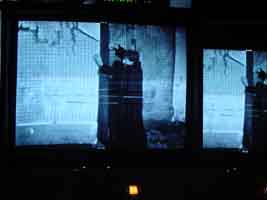|
A
new process is currently being used to spruce up some of the
old Doctor
Who
stories Keri Allan goes behind the scenes to find out more...
"In
1992 a small group of Doctor Who fans within the television
industry approached the BBC's Television Archivist with a
view to securing funding for a unique project - the experimental
restoration of a monochrome Jon Pertwee story back to its
original colour form." This is the opening quote from the
Doctor Who restoration team's website (http://www.restoration-team.co.uk).
Since then the group has worked on restoring Who classics
including Planet of the Giants and Tomb of the Cybermen
for the ultimate in quality video and DVD release.
Back
in the days before colour television was invented, the only
way to archive the black and white transmissions was to point
a film camera at a video screen - a process known as telecine.
This was done for two reasons - cost: in the 1960s videotape
was very expensive (around £200 an hour at a time when 60
minutes of TV could have a budget of just £2,000), and profit:
many foreign TV stations could were not equipped to run videotape.
So the tapes of shows were transferred to film for sale and
the video wiped for re-use. As a result, the vast majority
of the UK's archive TV survives on film. Unfortunately, transferring
tapes to film seriously degrades the image.
 |
Team
member and freelance video technician, Peter Finklestone,
developed a procedure which reinstates the missing field data,
reproducing the visual feel of the original video recording.
The process, called VidFIRE (Video Field Interpolation Restoration
Effect), interpolates the lost fields using motion-estimating
software similar to that used to create the 'bullet time'
effect used in The Matrix to create its time-bending
visuals.
Basically
the VidFIRE process creates a half-speed version of a film
transfer which is then speeded up to real time but with the
new frames interlaced as fields. Early attempts with its predecessor,
Video Field Artificial Restoration Technique (charmingly shortened
to VidFART), produced smearing and artefacts, especially when
there was a large amount of movement against a detailed background.
But the process has now been refined to broadcast quality
and fans of archive TV may now be able to view a show in better
quality than when it was first aired.
 |
 |
| Before |
After |
As
well as receiving VidFIRE treatment, episodes were also given
a more traditional sprucing up - visual defects including
scratches and dust were painted out from individual frames
- a process which takes weeks to complete. Frames can often
be repaired by using another frame from either side and superimposing
it over the damaged picture to remove a scratch or dust. Finklestone
said: "a very important part of the process is the removal
of as much film artefact - dirt, white sparkle. This is done
on a painstakingly frame-by-frame basis. This can take between
four and 20 hours per half hour show depending on the amount
of print damage. More complex areas of damage, especially
on moving scenes, can require a lot of careful thought and
different techniques to repair." Other work including sound
repairs are also completed when restoring episodes.
 |
The
team is currently working on the DVD release of another vintage
William Hartnell time travelling yarn, The Aztecs. The DVD
was due as the second release of 2002, but was put back to
give time for more work using VidFIRE due to processing time.
Team member Steve Roberts said: "Because of the extra time
involved in processing the story, currently a week per episode,
it was decided to swap 'The Aztecs' and 'Carnival of Monsters'
to give us a little more time to ensure that results were
as perfect as possible." Work is going well on the restoration
so far, as the team are working on a very high quality transfer
of the original negative. "Its going to look very good and
certainly belie its age (38 years old). It will probably have
had about 30 hours of manual clean-up, plus 11 days of processing
time," said Finklestone.
There
have been some corrections needed, however things are not
looking too bad. Episode one has been completed with approximately
2000 corrections made, and the remaining episodes are looking
cleaner and should involve a little less work. Already the
team is looking at what likely DVD extras will be added to
the disc for release. Roberts said: "These will definitely
include the now obligatory commentary, production subtitles
and photo gallery. We are also looking into using the Arabic
soundtrack for episode four [a private collector owns this],
a design featurette with Barry Newbury and possibly a historical
documentary about the Aztec belief in human sacrifice to appease
their gods. Looking set to hit their April deadline without
problems, this could be a good year for DVD collecting for
classic Who fans.
|
1992
saw the release of Tomb of the Cybermen on VHS (above
left). Now 10 years later thanks to the Doctor Who restoration
team fans of the show can watch a version of the series
that is superior in quality to the original broadcast. |
Return
to...

|